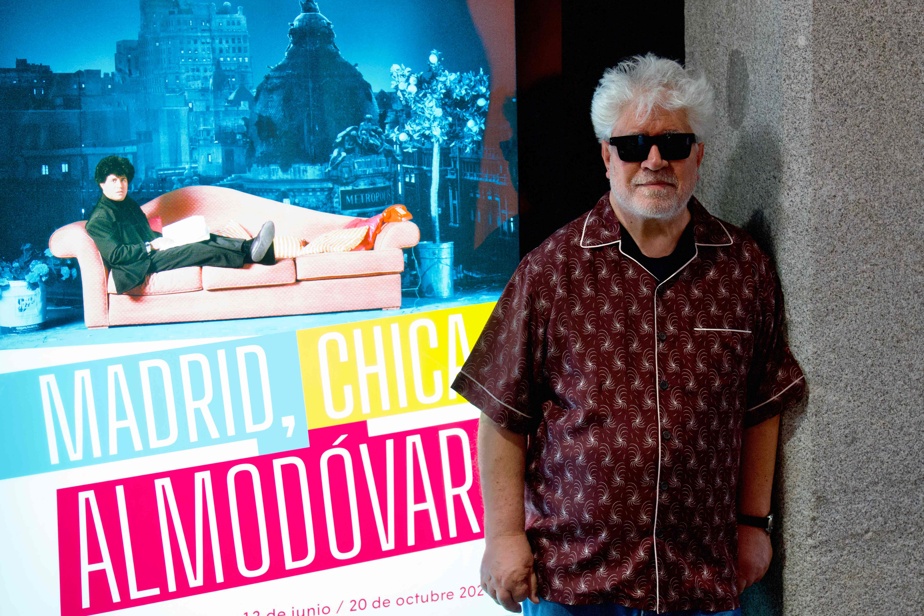(Madrid) Women’s filmmaker, Pedro Almodóvar has the reputation of being faithful to a handful of actresses playing his heroines, but his muse of yesterday and tomorrow is Madrid. Until October 20, the city pays tribute to this loving relationship through the exhibition Madrid, chica Almodovar.
“The story of Pedro Almodóvar and Madrid is a story of mutual love. Pedro Almodóvar is Pedro Almodóvar thanks to Madrid, they are inseparable,” explains the curator of the exhibition, Pedro Sánchez, author of Todo sobre mi Madrid (All about my Madrid). Walk through Almodóvar’s Madridreferring to All about my mother (1999).
“He gave back to Madrid everything she had given him, and more, as her muse. Madrid appears in all of Almodóvar’s films. She is the real “almodóvar chica” (the Almodóvar girl), much more than Penelope Cruz, Carmen Maura or Marisa Pérez,” he continues while wandering through the exhibition.
To welcome him, he only saw the Conde Duque cultural center: it is in front of its facade that Carmen Maura asks in The law of desire (1987) to a municipal employee cleaning the street by spraying it with water. The unforgettable night scene immortalized the actress in her orange dress, suffocated by the heat of the city in summer.
“Many foreigners know Madrid or Spanish culture through its films. Like we go to the Trevi Fountain in Rome or to the Amélie bar in Paris, we have a first contact with Madrid with its cinematography,” explains Mr. Sánchez.
Through 200 photos from Almodóvar’s 23 films or personal archives, we discover the relationship between the artist from Castile-la-Mancha and the capital.

PHOTO PIERRE-PHILIPPE MARCOU, AGENCE FRANCE-PRESSE
The first camera used by the director is on display in Madrid.
A panel shows a study detailing the percentage of action set in Madrid in all its cinematography: 6% (The skin I live in2011) at 100% for seven films.
“I have never felt like a foreigner here,” the filmmaker likes to say, who “shares with his favorite city a transgressive, eclectic, critical, open, cheerful, cosmopolitan and friendly personality,” according to Pedro Sánchez.
“This is my life”
This adopted son of Madrid, today the most international Spanish filmmaker, did not come from a good family, unlike most other Spanish artists of Movida, the period of socio-cultural liberation which followed the death of the dictator Francisco Franco in 1975 and the advent of democracy.
“He also says that being a filmmaker in Spain is like being a bullfighter in Japan,” laughs the commissioner.
Fleeing the Madrid of postcards, he does not hesitate to place his camera in the more popular neighborhoods, with their less obvious beauty, like Vallecas or Concepción.
While a map of Madrid reproduces the 272 locations counted in his films, the exhibition also notes the places obsessing the artist: taxis, hardware stores, cemeteries or pharmacies which dot his work.

PHOTO IGLESIAS MAS, CENTRO CONDEDUQUE, PROVIDED BY AGENCE FRANCE-PRESSE
Pedro Almodóvar
As Jacques Demy had Rochefort repainted for his “Demoiselles”, Almodóvar sometimes resorted to artifices to beautify Madrid.
“The colors are very important and completely fictitious. This comes from his memory of Franco’s Spain, in black and white. His way of getting revenge, according to him, is to flood his films with color,” explains Mr. Sánchez.
The visitor can thus see the backdrops used to reproduce Pepa’s terrace with panoramic views over all of Madrid in Women on the verge of a nervous breakdown (1988), because it would never have supported the weight of the filming equipment.
“It’s an idyllic Madrid” that we see in Parallel mothers (2021) or Julieta (2016), where the heroines have huge apartments in Madrid despite an average standard of living.
The Almodovarian aesthetic goes so far as to recreate masterpieces by Magritte, Rothko, Velasquez, Dali, Titian, Hopper… in the shots of his films, as deciphered in a video.
The filmmaker put a lot of himself into his settings: “Almodóvar’s houses, we didn’t see them in magazines like some filmmakers, but in his films,” says Pedro Sánchez, who recalls that Pain and glory (2019) reproduces his current apartment in Madrid, with some of his own armchairs.
“This is my life,” the filmmaker reportedly said when he visited the exhibition, before the public and far from the cameras.
